Belt and Road Initiative: Colombia strengthens economic ties with China, heralding an impactful shift in global trade relations.

Colombia Joins China’s Belt and Road Initiative
,The global trade and infrastructure landscape took a significant step forward as Colombia officially joined China’s Belt and Road Initiative (BRI). This landmark decision was formalized during high-level talks between Colombian President Gustavo Petro and Chinese President Xi Jinping in Beijing. The agreement represents a shift in Colombia’s geopolitical stance, as the nation seeks to diversify its international partnerships while balancing its historically strong ties with the United States.
,Strategic Implications for Colombia
,Colombia’s inclusion in the BRI marks a calculated geopolitical and economic gamble. By aligning itself with China’s ambitious infrastructure and trade program, Colombia positions itself to tap into the vast economic resources that China offers. The Colombian government believes that enhanced trade with China, particularly focusing on expanding exports, could bring robust economic growth to its Pacific coastal regions where industrial advancements remain untapped.
,For Colombia, this collaboration is an opportunity to join a global initiative that has over 20 Latin American participants. Among these nations, the infrastructure-driven cooperation has been a game-changer, creating new trade pathways and economic zones. China’s increasing influence in Latin America stands to challenge the long-standing dominance of the United States in the region.
,China’s Strategic Expansion in Latin America
,China’s Belt and Road Initiative has already become a geopolitical force to be reckoned with. Several Latin American countries, despite their proximity and history with the U.S., have embraced China’s vision for global commerce. The BRI serves as a link between Asia and Latin America, creating unprecedented opportunities for infrastructural development, technological advancements, and trade exchanges.
,China’s commitment to Latin America highlights its strategic desire to forge deeper connections in regions where the United States has historically held sway. While this may raise geopolitical eyebrows in Washington, for countries like Colombia, the immediate promise of increased economic ties and improved infrastructure outweighs potential political risks.
,A Shifting Dynamic in Global Trade Relations
,The participation of Colombia in the BRI adds momentum to China’s ambitious efforts to unify global trade under its economic umbrella. As Colombia takes steps to increase exports to China, this partnership also reflects a broader shift in global trade dynamics. Latin American countries, long considered the backyard of U.S. foreign policy influence, are demonstrating a willingness to diversify their partnerships and prioritize economic pragmatism.
,Colombia’s alignment with China signifies a recalibration of its global strategic priorities. For Bogota, the allure of participating in an initiative that promises exceptional economic dividends outweighs the risks of straining its relations with the U.S. Furthermore, China’s practical approach, by focusing on bilateral investments and minimizing involvement in domestic political issues, is increasingly gaining traction among nations around the world.
,Conclusion: A Game-Changing Partnership
,Colombia’s decision to join the Belt and Road Initiative represents a turning point in its economic and geopolitical trajectory. While the United States remains Colombia’s largest export destination, this partnership with China introduces a new player into its strategic landscape. The BRI offers a pathway for Colombia to build corridors of real economic transformation. How this decision will impact its longstanding relationships with Western nations remains to be seen, but it underscores the complex but unignorable rise of China as a global partner for trade and development.
Commentary
Colombia’s Strategic Gamble
,Colombia’s decision to partner with China under the Belt and Road Initiative reflects a broader trend of Latin American nations diversifying their economic alliances. In doing so, Colombia is aiming to leverage its Pacific coastal infrastructure to increase its exports to China—a necessary step to rebalance economic growth across its regions. This partnership represents a potentially transformative shift, rebalancing power between Latin America’s traditional ties with the U.S. and emerging global investment opportunities spearheaded by China.
,The ramifications of this decision extend beyond economics. China’s influence in Latin America has often been met with skepticism in Washington, and this growing alignment may lead to friction in U.S.-Colombian relations. However, for Colombia, the immediate benefits are enticing—expanding trade opportunities, access to Chinese investments, and participation in a multilateral initiative designed to connect and uplift economies through innovative infrastructure projects.
,A New Chapter in Latin America-China Relations
,By joining the BRI, Colombia follows in the footsteps of over 20 other Latin American nations seeking to broaden their options in foreign policy and economic development. Where critics see potential risks associated with dependency on Chinese funding, participating nations see opportunities for growth and modernization. For a developing nation like Colombia, the BRI might provide the much-needed investments to transform its industrial base and create new avenues of prosperity, particularly in underdeveloped areas.
,In essence, Colombia is taking a calculated risk that could enhance its global profile. The BRI offers compelling promises, and while challenges remain, such strategic partnerships have the potential to yield results both in the short and long term. It is a balance between strategic patience and immediate action—a lesson that all nations seeking global partnerships must navigate.


